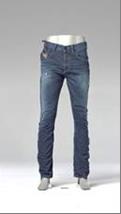Design Infringement: How Similar and in Whose Perspective? The Court, the Experts or the Customers?
Introduction
With the industry of innovation and technology thrusting all over the world, it is important that there is enough protection for originality, so as to boost incentive for more innovations. In the recent judgment of G-Star Raw CV v Rhodi Ltd [2015] EWHC 216 (Ch), the English Chancery Division had upheld that if there are similarities in the features of an artistic work (but not necessarily the work as a whole), an action in design infringement may be viable.
G-Star Raw CV v Rhodi Ltd
Facts
The Claimant (“G-Star”) is one of Europe's leading denim fashion brands and designers of contemporary urban garments. It owns unregistered design rights in the design of a style of contemporary jean trousers known as the “Arc Pant”. It alleged that 9 separate styles of jeans marketed under the “Voi” brand, which is owned by the Defendant (“Rhodi”), infringed its unregistered design right by copying Arc Pant, by substantially reproducing the majority of the prominent features of the two Voi styles complained of in the previously comprised proceedings, and therefore commenced the present claim.
The figures below illustrate the designs in dispute.


The Arc Pant The Jurien (one of the Rhodi style jeans)
Legal Analysis
In analysing whether there was primary infringement of design rights (i.e. directly copying the design so as to produce articles exactly or substantially similar to that design), the Court applied the test as follows:
1. Whether there is such subsistence of the design right and that the Claimant acquired ownership of it;
2. Whether all or any of the alleged copying articles were made substantially similar to the original design;
3. Whether the substantially similar parts were copied from the original design, or were instead the result of an independent but convergent design process. Upon the failure of the Defendant to prove this, the court would rule that there is strong inference that the product is made substantially similar to the original design as alleged in the present case.
The Court held that the design subsists and is owned by G-Star. The designer G-Star called as witness gave a clear and compelling account on the detailed design process which resulted in the creation of the Arc Pant, which was further supported with contemporaneous documents. Rhodi’s expert witness gave evidence that there was no substantial similarity between Rhodi’s designs and G-Star’s, and that there was instead use of style ideas of usual high street designs. The Court rejected that evidence and remarked that although the measurements by Rhodi’s expert on the appearance suggest significant difference, had the measurements been precise and correct (which was not the case), it would have shown substantial similarity. Hence the Court held in favour of G-Star on subsistence and ownership.
On whether the alleged copying articles were made substantially similar to the original design, the Court ruled that one ought to look at similarities (in the eyes of customers to whom the designs are directed) not in the works as a whole but in the features. But if there is no possibility of prior access then the alleged similarity could only be a coincidence and not amount to infringement, no matter how unlikely that would be.
Notwithstanding that the incompleteness of documents concerning Rhodi’s design process was allegedly partly due to wholesale deletion of the email account of the lead designer and substantial deletion of that of another designer, the Court expressed scepticism about Rhodi’s good faith and held in favour of G-Star.
How about in Hong Kong?
Preference for Registered Design Right
The regime governing protection of design right in Hong Kong is similar to that in England, with the exception (among others) that in Hong Kong there is no express provisions protecting “design right” other than “registered design right”. Therefore, in order to better protect their works, designers are advised to have their designs registered. Although the designers can still try to protect their “unregistered design” by claiming against the infringer for copyright infringement in Hong Kong, this route is less swift.
This advantage of a registered design is particularly significant in the situation of claiming against infringers at international exhibitions in Hong Kong. The exhibition organisers will swiftly remove the infringers from the exhibition if your works are protected under a registered design, because a registered design certificate is a prima facie evidence of subsistence and ownership of the design right. On the other hand, if you are only claiming for copyright infringement, the exhibition organisers will be reluctant to remove the alleged infringers, because the organisers are unable to decide whether there is originality in the works which give rise to a copyright, and who is the real owner of the copyright.
Infringement
Apart from the absence of distinction of treatment between primary and secondary infringement, the test for infringement as applied in Hong Kong is similar to that in the England. In Hong Kong, when determining whether there is infringement, the test of imperfect recollection would be applied to see whether, with the inexpert eye of a customer, considering solely the shape and configuration and not the object for which the article was made, the design of the alleged infringement is the same or not substantially different from the registered design. Also, there should be prior access to the original design, and only earlier designs which are likely to be known to the interested addressees would count.
As such the ruling in G-Star Raw CV v Rhodi Ltd is likely to be applicable in Hong Kong, and it is likely to extend to infringement of artistic copyright in general, i.e. that in other articles of which the visual appearance is crucial, such as cookware and toys.
Conclusion
The decision in G-Star Raw CV v Rhodi Ltd has to a certain extent clarified the law on design infringement. Although at times such could potentially involve subjective determination, expert witnesses may assist in pointing out the similarities and differences for the Court to make a better informed determination. But before all these could be issue, the Claimant’s right to design needs to be subsisting, and a valid and current registration of designs in Hong Kong certainly supports a finding of subsistence.
For enquiries, please contact our Intellectual Property & Technology Department: |
E: ip@onc.hk T: (852) 2810 1212 19th Floor, Three Exchange Square, 8 Connaught Place, Central, Hong Kong |
Important: The law and procedure on this subject are very specialised and complicated. This article is just a very general outline for reference and cannot be relied upon as legal advice in any individual case. If any advice or assistance is needed, please contact our solicitors. |
Published by ONC Lawyers © 2015 |








